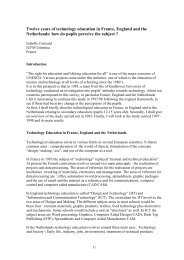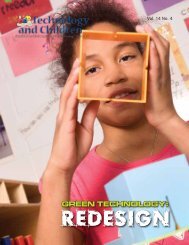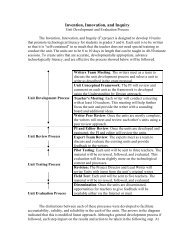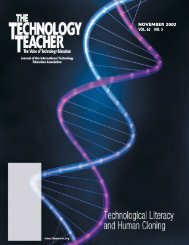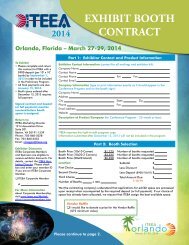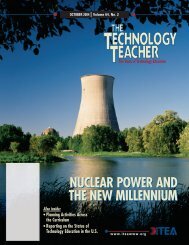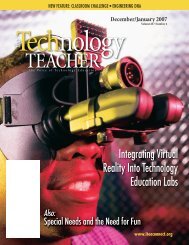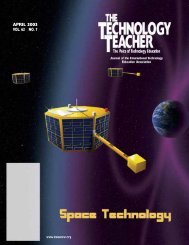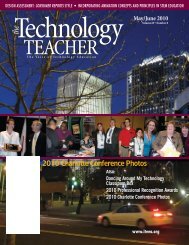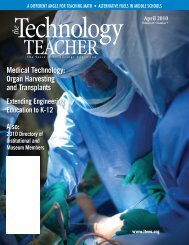May/June 2009 - International Technology and Engineering ...
May/June 2009 - International Technology and Engineering ...
May/June 2009 - International Technology and Engineering ...
You also want an ePaper? Increase the reach of your titles
YUMPU automatically turns print PDFs into web optimized ePapers that Google loves.
Most television production technology classes have limited<br />
resources. Students need to work closely with their media<br />
center <strong>and</strong> technology teacher to find out when they may<br />
check out equipment <strong>and</strong> for how long. With the high cost<br />
of checking out this type of equipment, it is important<br />
for student producers to make sure their crew <strong>and</strong> actors<br />
show up as scheduled in order to make efficient use of the<br />
cameras (Harrison, et al, 2005).<br />
Summary<br />
Throughout this article, it is the hope of the authors that<br />
an explanation of the twelve steps of preproduction could<br />
be used as a communications technology design tool in<br />
both the video production classroom <strong>and</strong> the technology<br />
education classroom. It is important to note that not<br />
every step has to be used because of the variety in the<br />
types of video productions. To successfully complete most<br />
productions with the true purpose for which they were<br />
intended, the brainstorming steps (Steps 1-6) are always<br />
utilized. The treatment (Step 7) as well as scriptwriting <strong>and</strong><br />
storyboarding (Steps 8 <strong>and</strong> 9 respectively) are developed<br />
after the brainstorming steps. After the script has been<br />
written <strong>and</strong> the storyboard has been created, camera<br />
<strong>and</strong> lighting blocking during location scouting is usually<br />
completed. Finally, Steps 10-12, which describe the logistics<br />
of the production, are completed. Although all video<br />
productions have crew requirements, this step, along with<br />
budgetary concerns, is not always applicable in regards<br />
to video productions created in technology education<br />
classrooms.<br />
Television production technology is a design-centered,<br />
st<strong>and</strong>ards-based curriculum that can be incorporated<br />
into technology education classrooms across the country.<br />
With the ever-increasing engineering design <strong>and</strong> STEM<br />
initiatives, communications technology <strong>and</strong> television<br />
production technology may be overlooked as designbased<br />
courses that can help students achieve technological<br />
literacy. Authentic design projects using the twelve steps of<br />
preproduction used in the film, television, <strong>and</strong> advertising<br />
fields offer an excellent means to teach students a sequential<br />
<strong>and</strong> creative process of design, an important goal of<br />
St<strong>and</strong>ards for Technological Literacy (2000/2002/2007).<br />
References<br />
Harrison, H., Lovel<strong>and</strong>, T., Deaton, V., & Squibb, K. (2005).<br />
Film technology. In R. Peterson (Ed.), The TECH-know<br />
project: High school student edition 2. (pp. 18–23).<br />
Cincinnati, OH: Centre Pointe Learning.<br />
St. Petersburg College technology education students check<br />
the storyboard to the script.<br />
<strong>International</strong> <strong>Technology</strong> Education Association.<br />
(2000/2002/2007). St<strong>and</strong>ards for technological literacy:<br />
Content for the study of technology. Reston, VA: Author.<br />
Irel<strong>and</strong> Department of Education <strong>and</strong> Science. Storyboards.<br />
Retrieved September 25, 2007, from the Film Project<br />
for Primary Schools website: www.fis.ie/default.<br />
asp?PageName=Lesson7.<br />
Shulman, A. (1999). Storyboarding activity. Retrieved<br />
September 25, 2007, from The Multimedia Project:<br />
Project-Based Learning with Multimedia website:<br />
http://pblmm.k12.ca.us/TechHelp/Storyboarding.html.<br />
Warner, S. (2003). Teaching design: taking the first steps.<br />
The <strong>Technology</strong> Teacher, 62(4), pp. 7-10.<br />
Henry L. (Hal) Harrison, III is a clinical<br />
faculty member at Clemson University,<br />
Clemson, SC. He can be reached via email<br />
at halharrison@spamarrest.com.<br />
Thomas Lovel<strong>and</strong> is a professor in the<br />
Department of <strong>Technology</strong> Education at St.<br />
Petersburg College, Clearwater, FL. He can<br />
be reached via email at Lovel<strong>and</strong>.Thomas@<br />
spcollege.edu.<br />
23 • The <strong>Technology</strong> Teacher • <strong>May</strong>/<strong>June</strong> <strong>2009</strong>



